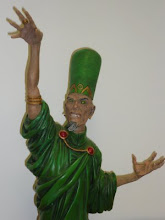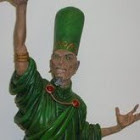 A very engaging and enjoyable first issue that manages the difficulties of setting up a story with great confidence. Crescent City in Lousiana is a layered city, the bottom layer is the Tarare Ward which is a deprived slum and the stamping ground for the Carriers gang and their leader Plague. A group of Carriers are out working and filling in a new recruit on how the it really works in Crescent City when the encounter a very significant problem.
A very engaging and enjoyable first issue that manages the difficulties of setting up a story with great confidence. Crescent City in Lousiana is a layered city, the bottom layer is the Tarare Ward which is a deprived slum and the stamping ground for the Carriers gang and their leader Plague. A group of Carriers are out working and filling in a new recruit on how the it really works in Crescent City when the encounter a very significant problem.Any first issue of a new story has very considerable problems to solve, the details and context of the story have to be established and at the same time sufficient story momentum has to be created to keep the readers on the hook for the next installment. Wade Price and Brian Berg solve these problems with wonderful confidence and smart details. The story opens with a crisp and to the point info dump that provides enough information for the reader to orient themselves before it dives straight into the action. By having a new member in the crew there is room to explain the details that are needed without every having break the narrative flow of the story. The gang gets to, literally, flex their muscles and show off for the new member and so for the reader as well. The action carries the explanations when the pace slows down it does so in an entirely natural manner.
The set up for Ghost is artfully done, the gang explain that Ghost is a significant problem and that they are worried for good reason, the reasons become entirely clear, when Ghost appears and delivers just as he should. His reputation is entirely justified.
One of the pleasures of the book is the time Wade Price and Brian Berg take to give the Carriers room to establish themselves as more than just thugs in masks. The conversations they have have a nice , sharp with and bravado, they enjoy the power they have and at the same time have a real fear of Ghost. By the time Ghost shows up and trouble really starts they have established themselves and the impact of Ghosts actions is much greater, they are not just convenient props to be killed. In particular he new gang member is given the opportunity to reveal himself. There is sufficient ambiguity created about the "good guys" who are attacking the "bad guys" to make the story lift nicely and offer interesting possibilities as the story progresses.
The art by Bob Raigen is striking and a pleasure to read. The panel s are used very well to control the tempo of the story, the action sequences are fast and engaging, the quieter moments are equally well done. The body language of the cast is very well conveyed and they are expressive and individual. The art is in a manga style and is nicely and very effectively exaggerated, this is just right for the story, it captures the heightened drama. The art is more than strong enough to carry the story by itself where it needs to and the creators have made smart decisions about where it should. The colouring is bright which matches with the story lines. I really like the sound effects and the dialogue lettering is as unobtrusive as it should be. Some of the caption boxes, in particular on the opening page look a little out of place, they do not merge as fully into page, they appear to have been laid onto the artwork. This means they slightly distract the reader as a separate element on the page and draw attention away from the art.
Overall a smart, engaging comic that delivers an interesting set up that leaves enough questions and possibilities to make the reader look forward to the next step in the story.
Chief Wizard Note: This is a review copy very kindly sent by Wade Price. If you would like to purchase a copy of Ghost (you should do so, the side effects from reading good comics include increased joy and happiness) it is available from insanecomics.com and comixology .





